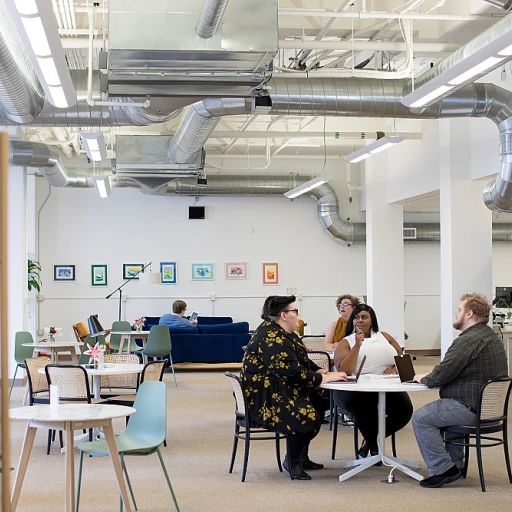
Understanding Succession Planning
The Importance of Strategic Replacement
Succession planning is a critical component for any organization aiming to sustain long-term success. It is not just about preparing for the inevitable changeover of key roles but also ensuring that the transition is seamless and the goals of the company remain uninterrupted. By fostering a pipeline of talent, businesses can address both anticipated and unanticipated changes within their workforce. The process begins with identifying pivotal positions that drive the success and culture of the company. These are roles where strong leadership is indispensable for the cohesion of team members and the overall morale in the workplace. It's essential to thoroughly understand the skills and qualities required for these positions to effectively carry out succession planning. Within this framework, recognizing the traits and characteristics that make an employee stand out becomes paramount. Navigating the early stages of succession planning involves a keen observation of employee traits that align with the organization's future needs. Characteristics such as work ethic, a positive attitude, strong communication skills, and the ability to adapt are highly valued. These qualities ensure that employees not only thrive individually but also contribute positively to the team dynamic, reflecting on the entire work environment. Furthermore, effective succession planning can mitigate risks associated with losing a vital team member. It also promises a continued alignment with the company's strategic objectives. By focusing on nurturing great employees today, businesses can ensure that there is a strong foundation for future leaders tomorrow. Questions about leadership styles and aspirations can offer valuable insights into how individuals may fit into future roles within the company structure. Seek more insights on leadership questions to deepen your understanding of how potential leaders align with your company's vision. In summary, succession planning is not merely a reactive response to impending vacancies but a proactive development strategy to equip employees for future roles. This ensures a robust, resilient company structure that thrives in the long term, supported by a culture that values continuous growth and adaptation.The Role of Employee Characteristics in Succession Planning
The Importance of Employee Characteristics in Organizational Growth
Understanding the intersection between employee characteristics and succession planning is vital for fostering a robust leadership pipeline. A strong focus on the traits of employees isn't just beneficial for immediate workplace efficiency; it plays a crucial role in shaping the long-term trajectory of a company. Employees with positive and strong workplace traits often become pivotal players within their teams. Key qualities such as communication skills, critical thinking, and emotional intelligence are invaluable. A great employee with a positive attitude stands out, contributing positively to the company culture and overall work environment. Teams rely heavily on employees who exhibit strong communication and soft skills. These qualities help in facilitating smoother interactions among team members, contributing to a more harmonious team dynamic. A great employee who is also a team player enhances the collective performance by promoting collaboration and sharing responsibilities. Attention to detail and effective time management are further qualities of great employees. An employee who is detail oriented often ensures the job is completed to a high standard, minimizing errors and improving productivity. Likewise, mastering time management can lead to better prioritization of tasks, helping the business achieve its goals more efficiently. Ultimately, investing in helping employees develop these traits is vital. It shapes a workforce poised for future leadership roles, thereby supporting succession planning efforts within the company. These motivational factors can help encourage employees to aspire to leadership roles, which is crucial for business growth.Key Traits of a Good Employee
Identifying Important Employee Traits
In the context of succession planning, recognizing the traits that constitute a strong employee is crucial for the long-term success of any business. By identifying individuals who exhibit these qualities consistently, organizations can secure a promising future. To begin with, strong communication skills are indispensable. Employees who communicate effectively foster a positive work environment and seamlessly convey ideas across different teams. Moreover, individuals with superior communication abilities contribute to a healthier company culture by ensuring a clear and open exchange of information. Being a team player is another essential attribute. Those who work collaboratively often enhance the collective productivity of their team. This quality is not only about working alongside others but also about being supportive and helping team members achieve common objectives. It is a significant factor that organizations should prioritize when evaluating employees. Moreover, possessing a positive attitude is invaluable. Employees with a positive outlook motivate those around them and instill an inspiring atmosphere that boosts morale, thereby significantly enhancing the workplace environment. Problem-solving and critical thinking capabilities are also paramount. Employees who can analyze situations, consider various perspectives, and arrive at practical solutions provide great value to a company. They often help navigate complexities and drive innovation, ensuring that the organization remains competitive. Additionally, being detail oriented and having excellent time management skills significantly contribute to an employee's effectiveness. These traits ensure that tasks are completed efficiently and punctually, reducing errors and streamlining processes within the workplace. Lastly, strong emotional intelligence underpins all of the above traits. It allows employees to manage their emotions, understand the feelings of others, and navigate interpersonal relationships judiciously and empathetically. This quality is especially critical in leadership positions and can be a distinguishing factor when spotting future leaders within the company. By focusing on these key traits, businesses can effectively prepare their teams for future challenges while ensuring a robust pipeline of good employees ready to step into higher roles as needed.Assessing Employees for Succession Planning
Evaluating Employee Potential for Future Leadership
When it comes to succession planning, assessing employees is a crucial step that ensures you're nurturing the right individuals for future leadership roles. Understanding how an employee fits into the long-term vision of the company is not only beneficial for growth but also reinforces a positive workplace culture. A well-rounded assessment should consider various aspects of an employee's performance and capabilities. Here are key factors to evaluate:- Technical Skills: While technical proficiency is essential, it's important to balance these skills with the ability to adapt and learn new ones. This flexibility is critical in an ever-changing business environment.
- Soft Skills: Attributes such as strong communication skills, emotional intelligence, and collaboration are often what differentiate good employees from great employees. These skills help create a work environment where team members can thrive and contribute positively.
- Problem Solving and Critical Thinking: A detail-oriented individual with strong critical thinking capabilities can navigate challenges effectively. This is an invaluable trait for leadership, where strategic decision-making is key.
- Work Ethic and Time Management: Consistently demonstrating a strong work ethic and the ability to manage time efficiently are indicators of reliability. Employees who excel in these areas often inspire confidence in their capacities to handle greater responsibilities.
- Positive Attitude: Often underestimated, a positive attitude can lead to a healthier work environment and company culture. This trait can enhance team dynamics and boost morale, which is vital for any leadership role.
- Adaptability and Willingness to Learn: Employees who are open to new ideas and eager to develop their skills show promise for leadership. This adaptability is a sign of resilience and a forward-thinking mindset necessary for growth.
Developing Employees for Future Roles
Investing in Employee Growth
Developing employees for future roles within a company is crucial for a successful succession planning strategy. This process not only benefits individuals in their career progression but also prepares the organization to maintain operational continuity. Creating and nurturing a strong work environment is essential. It's important to provide a setting where employees feel encouraged to grow both professionally and personally. This involves fostering a company culture that values skill development, continuous learning, and leadership mentoring.- Structured Training Programs: Implementing comprehensive training sessions tailored to enhance both technical and soft skills can significantly elevate an employee's readiness for more demanding roles. Workshops that focus on communication skills, problem solving, and critical thinking can help cultivate strong leaders.
- Mentorship Opportunities: Connecting team members with mentors who embody positive attitudes and expertise helps in transferring essential workplace skills and company knowledge. This significantly impacts their understanding of job responsibilities and fosters a collaborative team player mentality.
- Diverse Job Rotations: Allow employees to explore different roles within the company. This not only broadens their skills but also provides insights into various aspects of the business, encouraging a more holistic understanding of its operations.
- Feedback and Performance Reviews: Regular feedback helps employees identify strengths and areas for improvement. Constructive performance assessments can guide them in honing their detail-oriented skills and work ethic, ensuring long-term growth.
- Fostering a Positive Culture: Supporting a workplace culture that champions positivity can significantly boost morale and job satisfaction. Such an environment empowers employees, making them more invested in their roles and the future of the company.
Challenges in Succession Planning
Addressing Hurdles in Building a Resilient Workforce
Implementing an effective succession planning strategy is not without its challenges. As companies embark on this journey to identify and develop future leaders, several barriers can emerge, threatening to derail the process. Understanding how these obstacles intersect with employee traits and the organizational environment is key to overcoming them.
A primary challenge is ensuring that the skills and qualities of individual team members align with the long-term goals of the company. Every employee brings a unique set of strengths to the table, but these need to be harnessed strategically to support succession planning. An emphasis on soft skills, such as communication and emotional intelligence, is essential as these traits are crucial in nurturing a positive workplace and efficient team dynamics.
Furthermore, a strong organizational culture must be fostered to support growth and development. This culture should encourage problem-solving, critical thinking, and a positive attitude, allowing employees to thrive and prepare for future roles. Companies may struggle if there is a disconnect between the existing culture and the desired qualities of great employees. Bridging this gap requires deliberate efforts to integrate and reinforce the company's values and expectations across all levels of personnel.
Time management also poses a significant hurdle. The process of assessing and developing employees for future roles can be time-intensive, requiring a balance between immediate business needs and long-term development plans. Businesses often face pressure to focus on short-term results, which can impede the thorough evaluation of employee traits necessary for effective succession planning.
Lastly, maintaining open communication within the team and across departments is vital. Transparent dialogue helps in identifying employees who truly excel and demonstrate potential for leadership roles. This communication ensures that all team members, regardless of their current job, feel valued and empowered to pursue personal development, strengthening the overall succession strategy.












